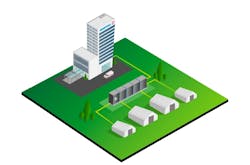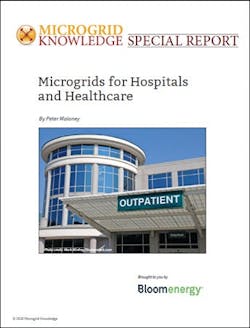Next up in this entry from our new special report series, we review why microgrids in hospitals may be a perfect fit — especially during COVID-19.
Get the full report.
It is hard to imagine an institution more critical to public health and safety than a hospital. Unfortunately, hospitals are also vulnerable to the wide range of threats — floods, hurricanes, wildfires — that can cause electric power outages. The loss of power at a hospital, however, can be particularly catastrophic. In addition to the ordinary functions performed by electrical service such as lights, communications, and heating and cooling, hospitals also need electricity for critical functions, including life support systems such as ventilators and dialysis machines, emergency room equipment, and diagnostic equipment and monitoring systems for everything from heart monitors to oxygen delivery systems. The loss of power to these critical systems could be life threatening. Hospitals also often function as a focal center for the surrounding community during emergencies by providing shelter from the elements.
Rising healthcare costs are
prompting pushback from consumers and legislators, resulting in lower reimbursement levels to hospitals. Photo credit: NicoElNino/Shutterstock.com
Hospitals not only have a more urgent need for electrical power than many other institutions, but they also use more power. Large hospitals account for less than 1% of all commercial buildings and 2% of commercial floor space, but they consume 4.3% of the total delivered energy used, according to the U.S. Energy Information Administration. And, despite energy efficiency inroads over the last two decades through the U.S. economy, hospital energy use is not declining. Nor is the overall carbon footprint of the industry.
Hospitals have high rates of energy consumption because they are open 24 hours a day, every day of the year, serving thousands of patients, employees and visitors who all require light, heat and cooling resources. In addition, hospitals also house many energy intensive activities such as laundry, food services and refrigeration as well as medical and lab equipment, sterilization machines, computers and servers, which also need energy to run. In general, hospitals use up to 2.5 times as much energy as commercial buildings of similar size.
Criticality and high use mean that hospitals have to take extra care to make sure they have reliable energy supplies. Regulators require hospitals to have some form of backup power, and they have more stringent and complex requirements for backup power than most commercial institutions. In short, hospitals must identify all loads whose failure can lead to patient injury or death, i.e., essential electrical systems, and back them up with a reliable source.
At the most basic level, hospitals must be able to provide essential electrical service to equipment whose loss would result in major injury or deat—in addition to the direct supply of power to that equipment.
Hospitals house many energy intensive activities such as laundry, food services and refrigeration as well as medical and lab equipment, sterilization machines, computers and servers, which also need energy to run.
Diesel generators are a common source of backup power but, as discussed earlier, they have several potential weaknesses, including limits on how much fuel can be stored on-site, potential fuel delivery issues, and the possibility that they will not perform when needed.
Some hospitals have already moved beyond diesel generator backup systems in favor of CHP plants that provide electricity and heat, making them more efficient and cost-effective to operate. CHP plants can also be configured as microgrids, which, in turn, can incorporate a variety of distributed energy resources (DERs), such as solar panels, wind turbines or fuel cells.
A microgrid can combine and control a variety of energy sources while monitoring and managing energy supply and demand. As a result, in an emergency, a microgrid can continue to supply the hospital with power when the surrounding grid goes down.
But its value is not confined to power outages; a microgrid operates 24/7/365 so it can supply day-to-day power capacity. Unlike backup generators that have to be maintained in order to ensure that they will work in an emergency, microgrids are always on duty. When not needed for backup generation, a microgrid also can help a hospital achieve its cost and sustainability goals by:
- Participating in various energy management programs, such as demand response, peak shaving and load management.
- Leveraging on-site generators and energy storage resources when electricity prices are high on the grid.
- Earning revenue from selling what are known as ancillary services to the grid. For example, at times the grid needs a sudden injection of power to maintain its supply/demand balance, such as when large wind or solar farms suddenly stop generating power because of the weather. A microgrid can apply that injection and gets paid to do so.
The potential of using a microgrid as both a source of backup power and a source of revenue is an important consideration for hospitals. Even as the threats that could necessitate the use of backup generation proliferate, hospitals are increasingly finding themselves under financial pressures that could put large capital projects out of reach. Many hospitals, particularly smaller and rural hospitals, are struggling financially. Despite a greater than ever need for healthcare services, costs are rising and profits are under pressure. A microgrid can also help hospital financial executives plan for the future.
In addition, rising healthcare costs are prompting pushback from consumers and legislators, resulting in lower reimbursement levels to hospitals. Many hospitals are also facing competition from lower cost clinics and ambulatory care centers. At the same time, facilities find themselves grappling with capital costs for new buildings, equipment and technology improvements, as well as rising labor costs.
Catch up on the first entry in the series here, that outlines a recent turning point for healthcare microgrids. The Second highlighted Healthcare Microgrid Types Growing as Options for Critical Facilities to Avoid Outages.
Stay tuned for the following articles further exploring the potential of the healthcare and hospital microgrid:
- Microgrids in Business Models
- Hospital Deployments and Microgrid Case Studies
Download the full report, “Microgrids for Hospitals and Healthcare,” free of charge courtesy of Bloom Energy.








